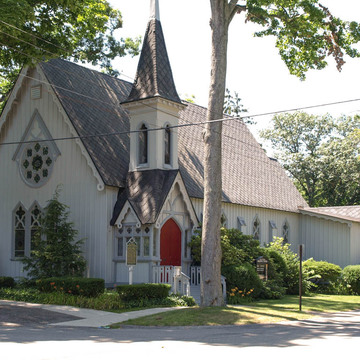All Saints Episcopal Church is one of the finest and best-preserved board-and-batten Carpenter Gothic churches in Michigan. Four years after the congregation was admitted to the Michigan Diocese in 1869, it selected Detroit architect Lloyd to design the church. Born and trained in England, Lloyd had Anglican connections that won him favor among those seeking designs for Episcopalian churches loosely based on the English parish church model. Lloyd knew the requirements of the Ecclesiological movement and his design for All Saints follows the movement's principles. Of all Lloyd's other Michigan churches, All Saints is most closely related to St. James Episcopal Church ( WN144), also an Ecclesiological church on Grosse Ile. All Saints was built by George Harnes, George E. Dunn, and William Dunning, highly skilled local carpenters who were part of the wood building tradition of ship carpenters present in Saugatuck. Their crisp and expressive interpretation of the “woodiness” of the building material is noteworthy.
This church has a steeply pitched gable roof and a spired open belfry over the vestibule at the northeast corner. Two-stage buttresses support the north and south walls and the walls are pierced with pointed windows and a rose window, all with foiled mullions. The church is embellished with scalloped vergeboards, trefoil and quatrefoil patterns, cross timbering, and ornamental hood moldings. The nave has a hammer-beam roof and vertical board-beaded wainscot. Historian James Schmiechen observes that the connecting parish hall and rectory addition equals the extraordinary building to which it was appended.


